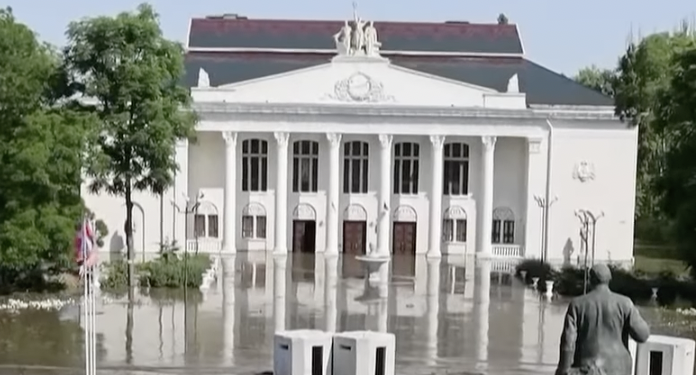In the early hours of June 6, a dam in the city of Nova Kakhovka in the Kherson Region of Ukraine collapsed, unleashing a monumental flood in eight villages so far.
The Kakhovka Hydroelectric Power Plant, built in the Soviet era, is one of six dams that hold crucial water reserves along the Dnipro River.
The Dnipro River is spectacularly big, stretching from the very north of Ukraine down into the sea at its southern coast. In the surroundings of the Nova Kakhovka dam, locals even call the river the Kakhovka Sea, as it can be impossible to see the opposite bank in some places.
The flooding has already caused severe damage, with evacuations of residents still underway. The Kherson Governor, Oleksandr Prokudin, said that 16,000 people were in the “critical zone,” while Ukrainian President, Volodymyr Zelenskyy, said 80 towns and villages were at risk of flooding.
Kakhovka Hydroelectric Power Plant
is not looking good.The evacuation has begun. According to Oleksandr Prokudin, the governor of the Kherson Onlast, in 5 hours the water will reach a critical level.#Russia #Ukraine #RussiaUkraineWar #RussiaIsATerroristState… https://t.co/9pkBOFHpcp pic.twitter.com/29A501RgPl
— Natalka (@NatalkaKyiv) June 6, 2023
A Ukrainian police officer in Kherson is seen rescuing a dog from a fish trap it was stuck in.#SlavaUkraini#OSINT #UkraineRussiaWar️ #UkraineWar #Ukraine pic.twitter.com/ra6oqg8V75
— OSINT (Uri)
(@UKikaski) June 6, 2023
The dam is situated in the Russian-occupied Kherson region and is home to vast reservoirs that hold water for various communities, especially farming ones, upstream.
The destruction of the dam thus holds not only immediate consequences for the families downstream of it, affected by the flood, but it could also be detrimental to tens of thousands of people that need the stored water for irrigation in the long term.
After 5 hours, the water level after the destruction of the Kakhovskaya hydroelectric power station will reach a critical level, Kiev announced the evacuation
About 16,000 people live in flood zones.#Ukraine #Kherson #ukrainecounteroffensive #Dnipro pic.twitter.com/SonmBgNyVV
— ZyK (@Zyklog) June 6, 2023
Another detrimental side effect of the destruction of the dam is the potential threat it would pose on the nearby nuclear power station at Zaporizhzhia, 100 miles upstream. Low water levels in the dam could hamper the “residual heat removal from the reactors,” from the spent fuel ponds, and the “cooling of the emergency diesel generators”, according to the International Atomic Energy Agency (IAEA).
The plant is under Russian control and could pose a danger, although the International Atomic Energy Agency said that their “current assessment is that there is no immediate risk to the safety of the plant.”
Related Articles: Surviving Extreme Heat in the Slums | What Sparked the Latest Anti-Government Protests in Poland? | How Russia Has Already Lost the War
The IAEA said that if the water in the dam falls below 12.7 meters, the lowest level after which it becomes impossible to pump water upstream, “there are a number of alternative sources of water” to cool down the plant, including “large cooling pond next to the site.”
Another important factor to consider is the impact of the dam breach on the water supply to Crimea.
Update to this thread I made over 2 years ago (roughly 11 months pre-invasion) isolating one of Russia’s motivators in it’s southern campaign in Ukraine, water:
The Crimean canal is now flowing backwards from Crimea into the Dnipro River. https://t.co/z2mNxKz5hg pic.twitter.com/JCInJ0dX3W
— OSINTtechnical (@Osinttechnical) June 6, 2023
Indeed, after the Russian annexation of Crimea in 2014, Ukraine blocked the primary freshwater canal to Crimea by damming. In the early stages of the Russian occupation of the Southern regions of Ukraine, that dam was reversed to allow the canal to reestablish the freshwater flow, which accounts for 85% of Crimea’s fresh water.
Yet, the destruction of the dam will again incrementally cut off Crimea’s water supply. Still, Sergei Aksyonov, the Russian-backed head of Crimea, said in a Telegram post that there’s no risk of flooding.
“Yet, there is a risk for the North-Crimean canal to shrink,” he added, ending the post by warning that the next couple of days will be essential to “understand the dynamics of the situation and possible risks.”
At this time, it is still unknown who was behind the Nova Kakhovka dam breach. Kyiv has accused the Kremlin of destroying the dam, as tweeted by President Zelenskyy, while Moscow called the destruction self-sabotage carried out by Ukraine to distract from the ongoing counter-offensive.
Neither of the claims was backed by evidence.
As the situation progresses, the safety of the population must remain the priority.
Editor’s Note: The opinions expressed here by the authors are their own, not those of Impakter.com — In the Featured Photo: Nova Kakhovka Palace of Culture flooded Featured Photo Credit: France24 Youtube video









